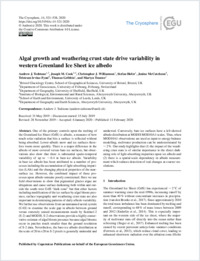Algal growth and weathering crust state drive variability in western Greenland Ice Sheet ice albedo
- Tedstone, Andrew J. Bristol Glaciology Centre, School of Geographical Sciences, University of Bristol, Bristol, UK - Department of Geosciences, University of Fribourg, Fribourg, Switzerland
- Cook, Joseph M. Department of Geography, University of Sheffield, Sheffield, UK - Institute of Biological, Environmental and Rural Sciences, Aberystwyth University, Aberystwyth, UK
- Williamson, Christopher J. Bristol Glaciology Centre, School of Geographical Sciences, University of Bristol, Bristol, UK
- Hofer, Stefan Bristol Glaciology Centre, School of Geographical Sciences, University of Bristol, Bristol, UK
- McCutcheon, Jenine School of Earth and Environment, University of Leeds, Leeds, UK
- Irvine-Fynn, Tristram Department of Geography and Earth Sciences, Aberystwyth University, Aberystwyth, UK
- Gribbin, Thomas Bristol Glaciology Centre, School of Geographical Sciences, University of Bristol, Bristol, UK
- Tranter, Martyn Bristol Glaciology Centre, School of Geographical Sciences, University of Bristol, Bristol, UK
-
11.02.2020
Published in:
- The Cryosphere. - 2020, vol. 14, no. 2, p. 521–538
English
One of the primary controls upon the melting of the Greenland Ice Sheet (GrIS) is albedo, a measure of how much solar radiation that hits a surface is reflected without being absorbed. Lower-albedo snow and ice surfaces therefore warm more quickly. There is a major difference in the albedo of snow-covered versus bare-ice surfaces, but observations also show that there is substantial spatio- temporal variability of up to ∼0.4 in bare-ice albedo. Variability in bare-ice albedo has been attributed to a number of processes including the accumulation of light-absorbing impurities (LAIs) and the changing physical properties of the near-surface ice. However, the combined impact of these processes upon albedo remains poorly constrained. Here we use field observations to show that pigmented glacier algae are ubiquitous and cause surface darkening both within and outside the south-west GrIS “dark zone” but that other factors including modification of the ice surface by algal bloom presence, surface topography and weathering crust state are also important in determining patterns of daily albedo variability. We further use observations from an unmanned aerial system (UAS) to examine the scale gap in albedo between ground versus remotely sensed measurements made by Sentinel-2 (S- 2) and MODIS. S-2 observations provide a highly conservative estimate of algal bloom presence because algal blooms occur in patches much smaller than the ground resolution of S-2 data. Nevertheless, the bare-ice albedo distribution at the scale of 20 m×20 m S-2 pixels is generally unimodal and unskewed. Conversely, bare-ice surfaces have a left-skewed albedo distribution at MODIS MOD10A1 scales. Thus, when MOD10A1 observations are used as input to energy balance modelling, meltwater production can be underestimated by ∼2 %. Our study highlights that (1) the impact of the weathering crust state is of similar importance to the direct darkening role of light-absorbing impurities upon ice albedo and (2) there is a spatial-scale dependency in albedo measurement which reduces detection of real changes at coarser resolutions.
- Faculty
- Faculté des sciences et de médecine
- Department
- Département de Géosciences
- Language
-
- English
- Classification
- Hydrology
- License
- License undefined
- Identifiers
-
- RERO DOC 328443
- DOI 10.5194/tc-14-521-2020
- Persistent URL
- https://folia.unifr.ch/unifr/documents/308562
Statistics
Document views: 89
File downloads:
- ted_agw.pdf: 166
